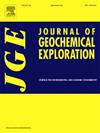结合电阻率成像(ERI)和地球化学方法分析废弃铜尾矿库的地质环境特征(中国铜陵)
IF 3.3
2区 地球科学
Q1 GEOCHEMISTRY & GEOPHYSICS
引用次数: 0
摘要
金属采矿尾矿库是一种亟待恢复和利用的土地资源,但由于有毒元素的积累和排放,也是一个重要的环境问题。中国铜陵市狮子山铜矿区废弃的水木冲尾矿库在近 34 年(1990-2024 年)的风化和水作用下,产生了大量由硫化物矿物组成的废弃物,尤其是表层,这些废弃物被侵蚀并扩散到更远的地方。在本文中,我们展示了一种成功的地球物理学和地球化学相结合的方法,用于探索此类矿床的地球环境特征,包括其几何形状和潜在风险评估。我们进行了超高密度电阻率成像(ERI)勘测,以确定该尾矿库内部结构的特征,确定氧化层的总体几何形状和尾矿的稳定性。通过对电阻率剖面的分析,可以看到与氧化铁覆盖层相关的低电阻率层,并提供了重金属沿高电阻率裂缝的潜在路径。此外,为了研究重金属浓度和土壤理化参数在深度上的变化,特别是与氧化铁覆盖层相关的变化,在 ERI 线下从表土到底土以 10 厘米的间隔采集了 9 个固体样品,并沿尾矿坝向下至农田分两条平行线采集了周围的土壤样品。此外,还采用了矿物学和地球化学表征技术(XRD、XRF 和 ICP-MS),以确定可能存在的重金属,从而对生态系统和人类造成危害,并对重金属污染进行评估。总之,应建议长期应用地球物理和地球化学技术,以尽量减少尾矿对受影响地区的环境影响,并为环境恢复提供科学依据。本文章由计算机程序翻译,如有差异,请以英文原文为准。
Geoenvironmental characterization of abandoned copper tailings pond combining electrical resistivity imaging (ERI) and geochemical methods (Tongling, China)
Metallic mining tailings ponds are a kind of land resource which should be rehabilitated and utilized urgently but are also a crucial environmental concern due to the accumulation and emission of toxic elements. The abandoned Shuimuchong tailings pond, from the exploitation of Shizishan copper mine district at Tongling City, China, has been exposed to aeolian and water agents for almost 34 years (1990–2024) generating a huge volume of waste composed of sulfide minerals, especially in the surface layer, which eroded and dispersed further afield. In this paper, we demonstrated a successful combined approach of geophysics and geochemistry to explore geoenvironmental characterization of such deposits, including their geometry and the potential risk evaluation. Super-high density electrical resistivity imaging (ERI) surveys were carried out for characterizing the inner structure of this tailings pond, determining both the general geometry of the oxide layer and the stability of the tailings. The analysis of resistivity profiles makes it possible to visualize a low resistivity layer associated with the oxidized iron covering and provide the potential pathways of heavy metal along fractures with high resistivity. Besides, in order to investigate the variation of heavy metal concentration and soil physicochemical parameters in depth, especially associated with the oxidized iron covering, 9 solid samples were collected under the ERI lines from topsoil to subsoil at an interval of 10 cm and the surrounding soil samples were collected along the tailings dam downward to the farmland in 2 parallel lines. Furthermore, mineralogical and geochemical characterization techniques (XRD, XRF and ICP-MS) were carried out to determine the possible occurrence of heavy metals that could entail ecosystem and human risks and the assessment of heavy metal pollution. In conclusion, the permanent application of geophysical and geochemical techniques should be recommended in order to minimize the environmental impact of the tailings on the areas affected, and also to provide scientific basis for environmental restoration.
求助全文
通过发布文献求助,成功后即可免费获取论文全文。
去求助
来源期刊

Journal of Geochemical Exploration
地学-地球化学与地球物理
CiteScore
7.40
自引率
7.70%
发文量
148
审稿时长
8.1 months
期刊介绍:
Journal of Geochemical Exploration is mostly dedicated to publication of original studies in exploration and environmental geochemistry and related topics.
Contributions considered of prevalent interest for the journal include researches based on the application of innovative methods to:
define the genesis and the evolution of mineral deposits including transfer of elements in large-scale mineralized areas.
analyze complex systems at the boundaries between bio-geochemistry, metal transport and mineral accumulation.
evaluate effects of historical mining activities on the surface environment.
trace pollutant sources and define their fate and transport models in the near-surface and surface environments involving solid, fluid and aerial matrices.
assess and quantify natural and technogenic radioactivity in the environment.
determine geochemical anomalies and set baseline reference values using compositional data analysis, multivariate statistics and geo-spatial analysis.
assess the impacts of anthropogenic contamination on ecosystems and human health at local and regional scale to prioritize and classify risks through deterministic and stochastic approaches.
Papers dedicated to the presentation of newly developed methods in analytical geochemistry to be applied in the field or in laboratory are also within the topics of interest for the journal.
 求助内容:
求助内容: 应助结果提醒方式:
应助结果提醒方式:


